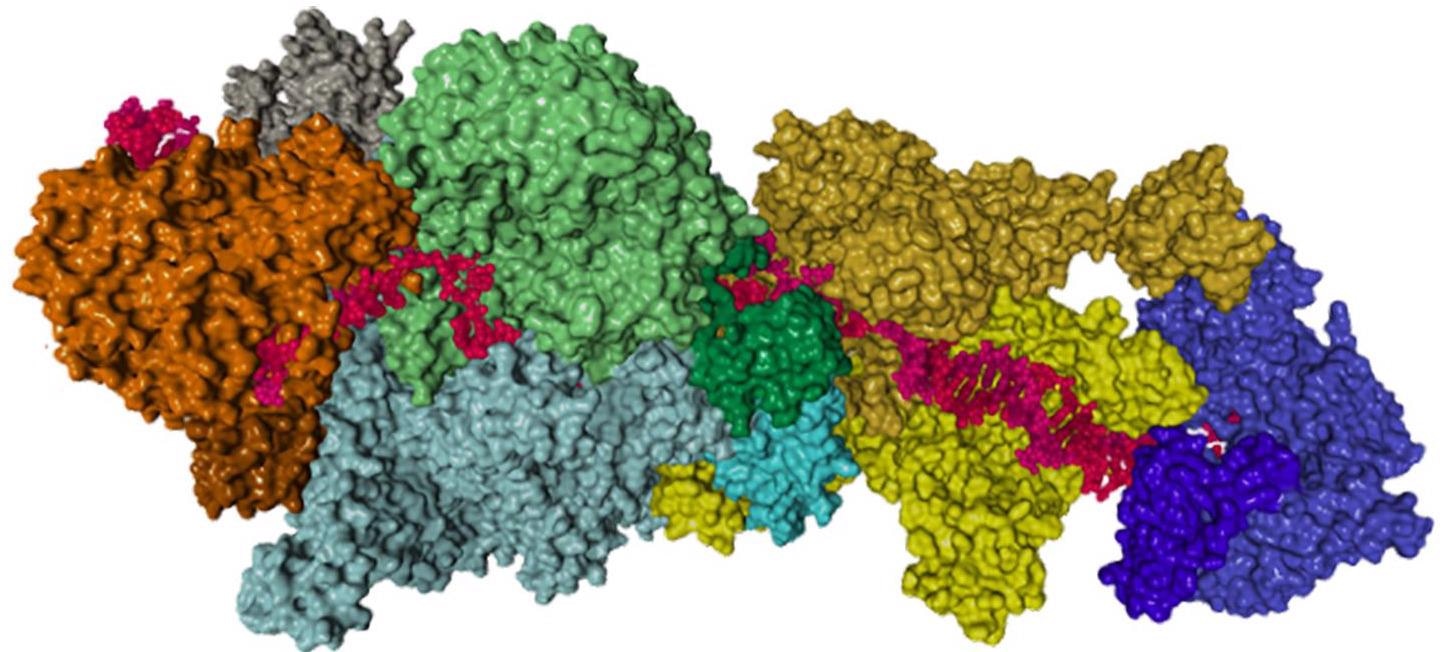Two recent research have shown a completely new perspective of how bacterial cells repair broken parts of their DNA (lesions).
 Proteins that assemble into the machinery needed for DNA repair in live bacterial cells. Image Credit: Bharati et al., Nature.
Proteins that assemble into the machinery needed for DNA repair in live bacterial cells. Image Credit: Bharati et al., Nature.
The investigation, headed by NYU Grossman School of Medicine experts, focuses on the delicate nature of DNA molecules, which are susceptible to damage from reactive byproducts of cellular metabolism, toxins, and UV radiation. Because damaged DNA can cause harmful DNA code changes (mutations) and death, cells have evolved DNA repair mechanisms.
However, how can these machines rapidly search for and detect unusual lengths of damage among the “vast fields” of unbroken DNA remains a key unsolved topic in the area.
TCR, or transcription-coupled repair, is a huge protein machine (complex) that drives along the DNA chain, reading the code of DNA “letters” as it transcribes instructions into RNA molecules, which then control protein construction, according to previous research. The TCR mechanism, however, was misunderstood before the present study, according to the study authors.
TCR was considered to have a little part in DNA repair because it relied on a putative TCR factor that provided only a minor contribution to DNA repair, according to widely recognized research, including studies that won a Nobel Prize in Chemistry in 2015.
Global genome repair (GGR), a parallel mechanism, was believed to scan and repair most of the DNA without relying on transcription. Both procedures were supposed to pave the way for nucleotide excision repair (NER), which clipped a damaged length of DNA and replaced it with an exact copy.
Now, based on the first-of-its-kind, multistage analysis of DNA repair in living Escherichia coli cells, a new study published online on March 30th in Nature and Nature Communications agrees that most, if not all, NER are combined with RNA polymerase, which scans the total microbial genetic code for damage.
Based on our results, we need to rethink some of the basic theories in the DNA repair field. A true understanding of such repair is a fundamental goal in medicine, as most antibiotics and chemotherapies kill disease-causing cells by damaging their DNA, and the ability to halt repairs would make such cells much more vulnerable to existing drugs.”
Evgeny A. Nudler, PhD, Study Senior Author and Investigator, Howard Hughes Medical Institute, NYU Langone Health
Nudler is also a Julie Wilson Anderson Professor of Biochemistry and Molecular Pharmacology.
Discovery pipeline
According to the current scientists, previous research did not adequately reflect the biological reality of NER in bacteria since researchers employed procedures that attempted to replicate complex protein interactions outside of living cells. As a result, the field has defined a protein named Mfd as the major participant in TCR, despite the fact that most DNA repair occurs whether or not Mfd is present.
As a result, TCR appeared to be a modest repair route. TCR was previously assumed to occur exclusively in highly transcribed DNA regions. GGR was considered to affect genomic sites that were seldom transcribed or sections of the genome that were assumed to be “non-transcribed.”
The study, which was recently published in Nature, used a ground-breaking technique known as crosslinking mass spectrometry (XLMS) to trace the distances between molecularly linked proteins and, as a result, determine the interacting surfaces of huge NER and polymerase complexes in living cells for the first time. The spectrometry data was then incorporated into computer-driven simulations, which resulted in accurate structural models.
RNA polymerase, contrary to popular belief, acts as the scaffold for the assembly of the whole NER complex, as well as the principal sensor of DNA damage. The main NER enzymes, UvrA and UvrB, were discovered to be brought to most lesions by RNA polymerase, rather than finding them on their own. The authors claim that this basic TCR mechanism is independent of Mfd.
The second study, which was conducted in live cells and published in Nature Communications, employed a high-throughput sequencing technology known as cyclobutane pyrimidine dimer sequencing (CPD-seq) to follow the formation of DNA lesions by exposure to ultraviolet light, and the rate of repair with a precision down to a single letter (nucleotide) in the DNA code.
Interfering with bacterial transcription with the antibiotic rifampicin shuts down repair throughout the bacterial genome, according to CPD-seq. According to the results, NER is strongly linked to transcription across the bacterial chromosome, which is the DNA framework that holds all of the genes.
Experiments revealed that when bacterial cells are exposed to DNA damage, they inhibit the function of the protein Rho, which is the global termination signal that signals RNA polymerase to cease reading. RNA polymerases read on and on as the stop signals were turned down, delivering the repair enzymes to DNA damage wherever it was found in the genome.
Given our findings, we theorize that eukaryotes, including human cells, also use RNA polymerase for efficient repair globally, as the bacterial TCR complexes described here have human analogs. Moving forward, our team plans to confirm the presence of global TCR in human cells, and if confirmed, to explore whether in the future repair might be safely boosted to counter diseases of aging.”
Binod Bharati, PhD, Study Co-First Author and Postdoctoral Scholar, Dr Nudler’s lab, NYU Langone Health
Source:
Journal reference:
Bharati, B. K., et al. (2022) Crucial role and mechanism of transcription-coupled DNA repair in bacteria. Nature. doi.org/10.1038/s41586-022-04530-6.